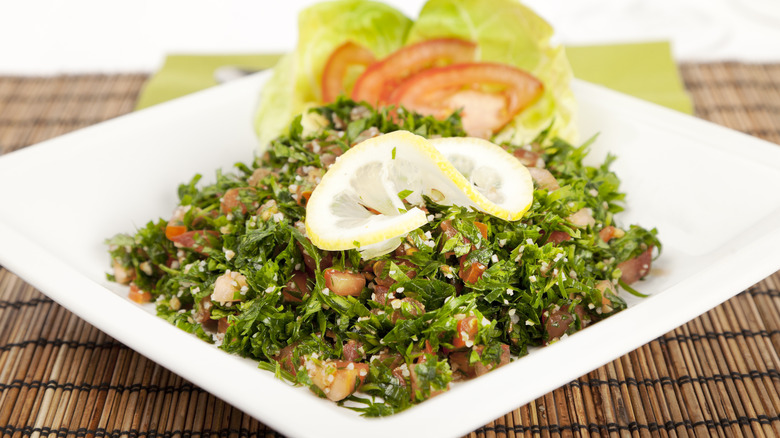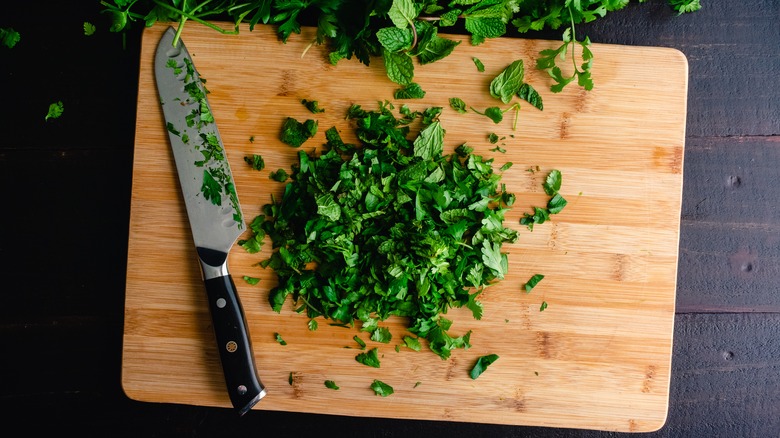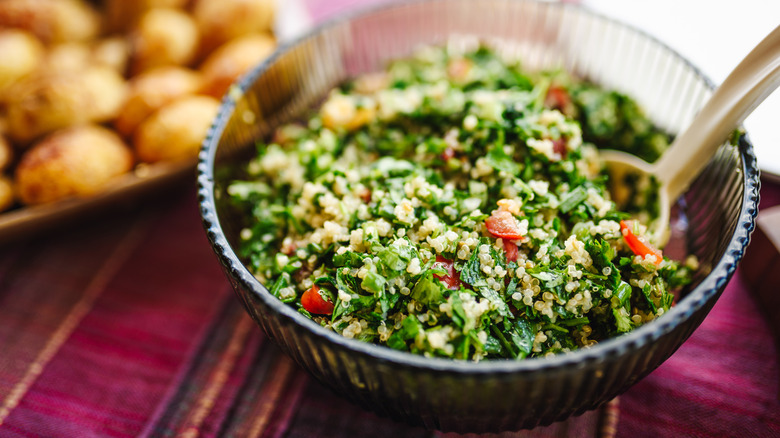The Reason To Avoid Using A Food Processor For Tabbouleh Salad
The magic of traditional Lebanese tabbouleh salad lies in its delicate, light texture. To create this herb-rich dish, you finely chop and combine parsley, mint, tomatoes, green onion, and bulgur, before dressing it all in a mixture of lemon juice and olive oil. Of course, creating this bright, balanced salad at home requires considerable prep work, making the idea of tossing each ingredient into the food processor seem appealing. While using a food processor to quickly prepare salad can be tempting, there's a reason it's not the best choice for this particular dish.
Parsley, being high in moisture, will not only bruise in the food processor, resulting in a loss of flavor, but it will also turn into a mushy parsley paste. You're aiming for small, fine pieces of fresh parsley here, not a stringy, pulpy mess. Taking the extra time and effort to chop your herbs by hand with a sharp knife will pay off, yielding a delicious salad with plenty of texture and complexity.
Chopping your herbs properly for a tabbouleh salad
Now that you've committed to assembling your tabbouleh salad by hand, you're not in the clear just yet. First, you must thoroughly wash and dry your parsley, and remove the leaves from the stems. A salad spinner is useful here to ensure all the excess moisture is wicked away. If the parsley isn't fully dry, your tabbouleh could end up too watery, and this applies to the mint as well.
You'll want to chop carefully to avoid bruising these fine, delicate herbs, which could turn them an unappealing brown and dampen their flavor. For chopping parsley, use the rocking method. Begin by holding your knife with your four fingers curled under for protection, and bunch up the parsley. Then, rock the knife back and forth along the bundle of parsley, keeping the tip of the blade always in contact with the cutting board. Repeat this motion, even making a crisscross pattern across the parsley until it's very fine.
For the mint, larger leaves require a slightly different technique. Stack the individual leaves and roll them up together. Turn the roll so it's horizontal, and hold it tight by gently grasping the roll with your fingertips. Then, start the rocking motion as you slice along the roll of mint. This will create lovely mint ribbons. Continue slicing the mint with the rocking technique to get it even finer.
Other tips for crafting the perfectly balanced dish
Now it's time to consider your other tabbouleh ingredients, like the tomatoes. Chopping tomatoes can result in tomato juice oozing everywhere, so it's best to start by removing the seeds and pulpy juice before finely dicing. You could also opt for a less juicy tomato variety, such as Roma tomatoes.
If you have a bit more time, activate osmosis by lightly salting your parsley and tomatoes before use. You can line a plate or bowl with a paper towel to absorb the moisture that the salt draws out. Pat the tomatoes and parsley dry, and reserve the juice for soaking the bulgur. Just be mindful that the amount of salt you add can affect the overall salt content of the tabbouleh salad.
Avoiding excess moisture from your other tabbouleh ingredients is crucial, but there's one liquid a tabbouleh salad is incomplete without: the dressing! A classic dressing for tabbouleh is simply made with a base of olive oil and lemon juice. Choose a high-quality extra-virgin olive oil to add a layer of fatty richness, while freshly squeezed lemon juice brings the perfect amount of brightness to this already fresh salad. Pair your tabbouleh salad with a side of delicious homemade hummus, gobble it up with some pita bread, and you have a refreshing dish that's well worth the time and effort to prepare by hand.


